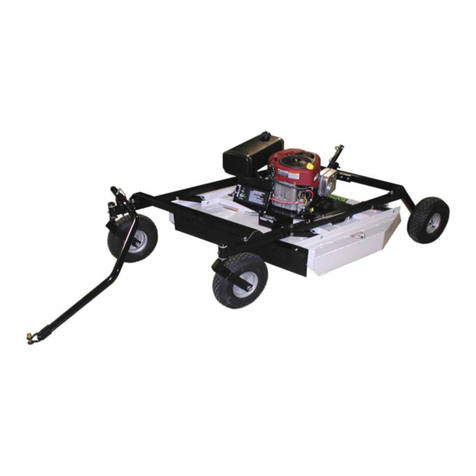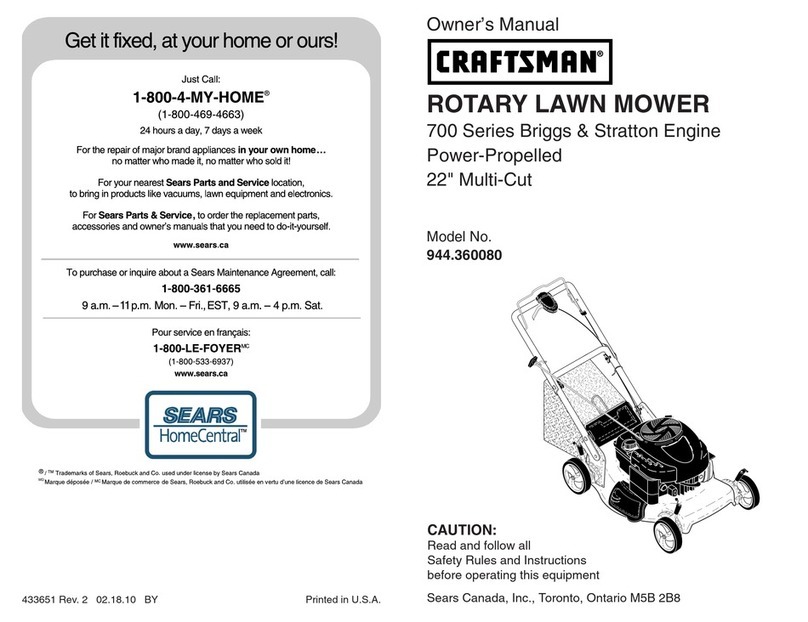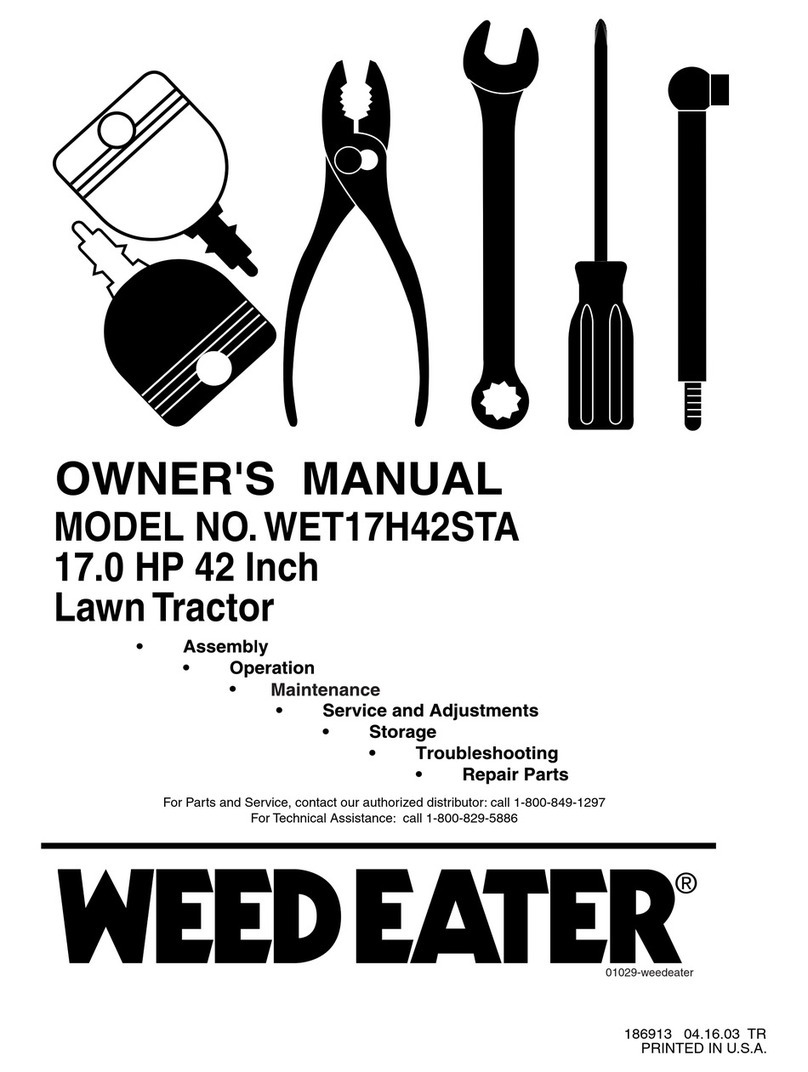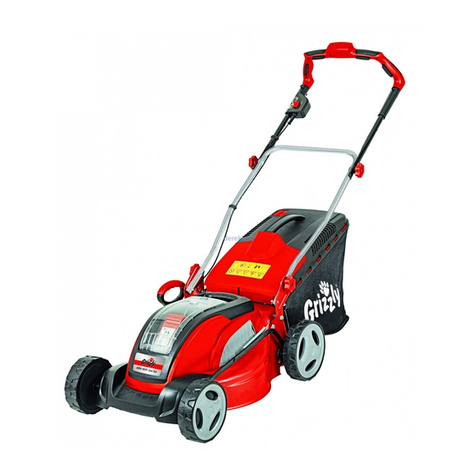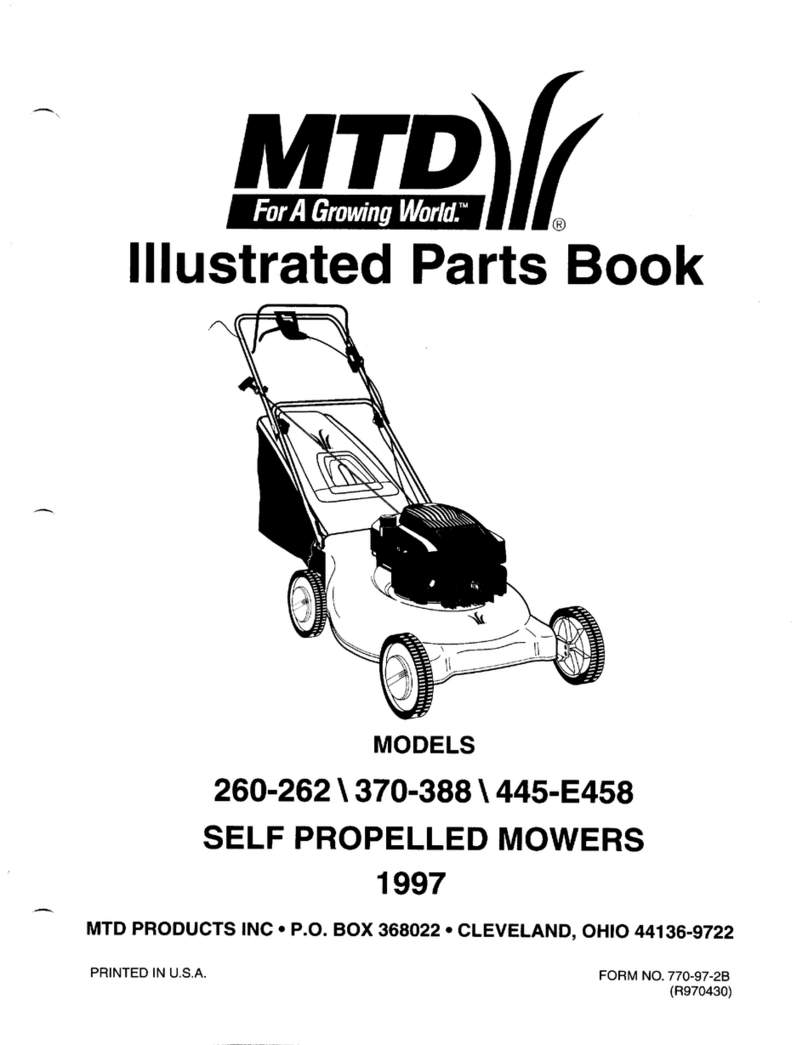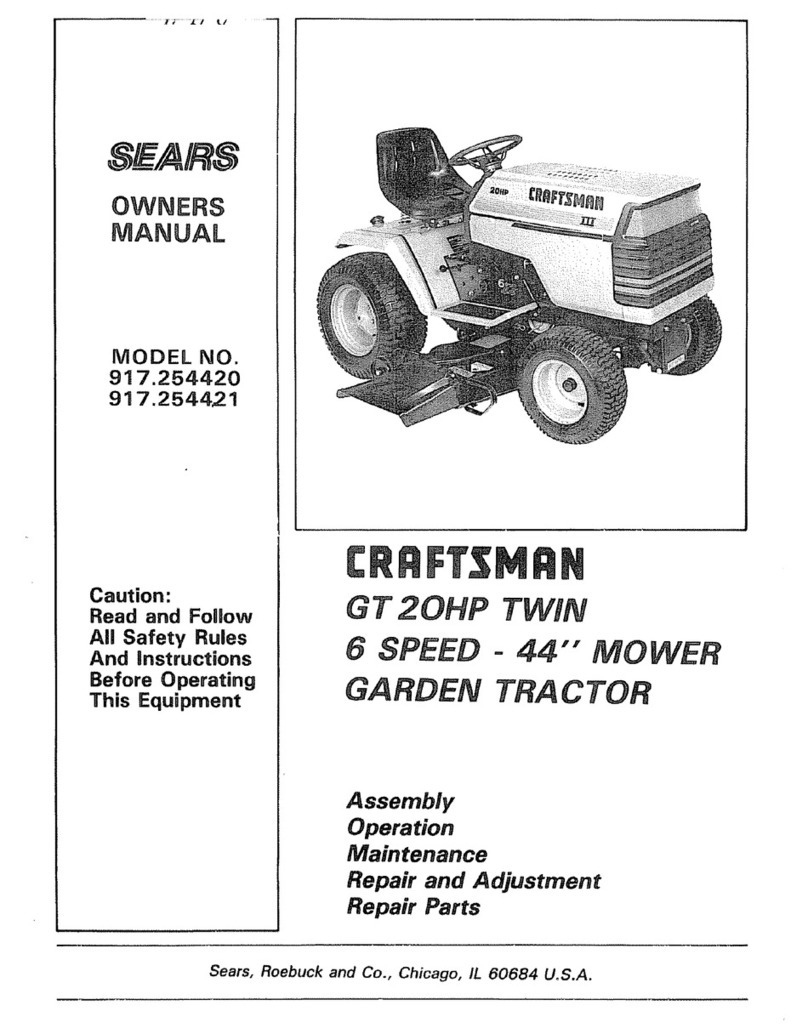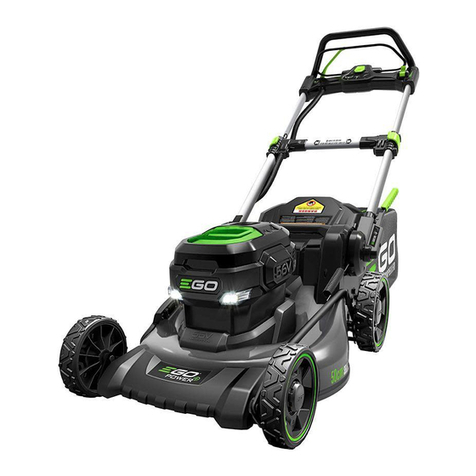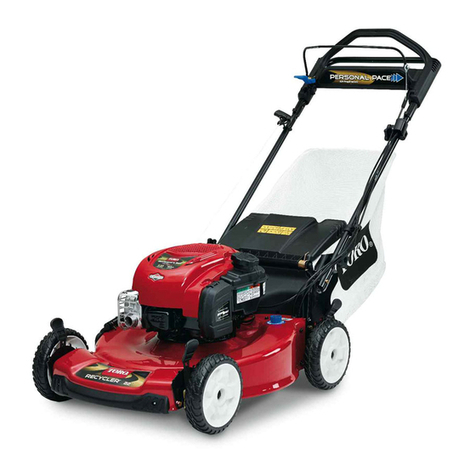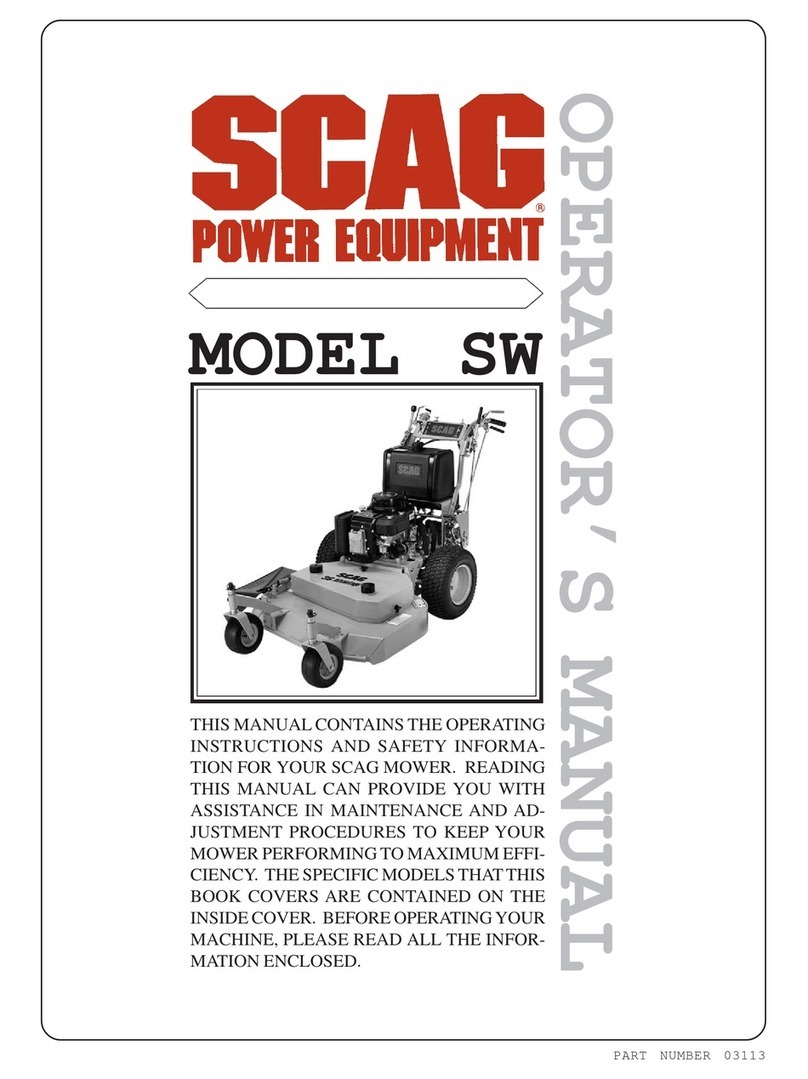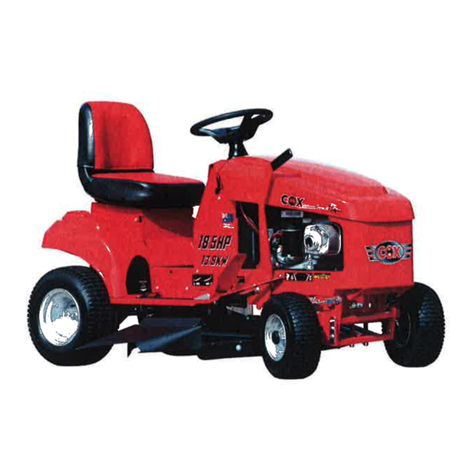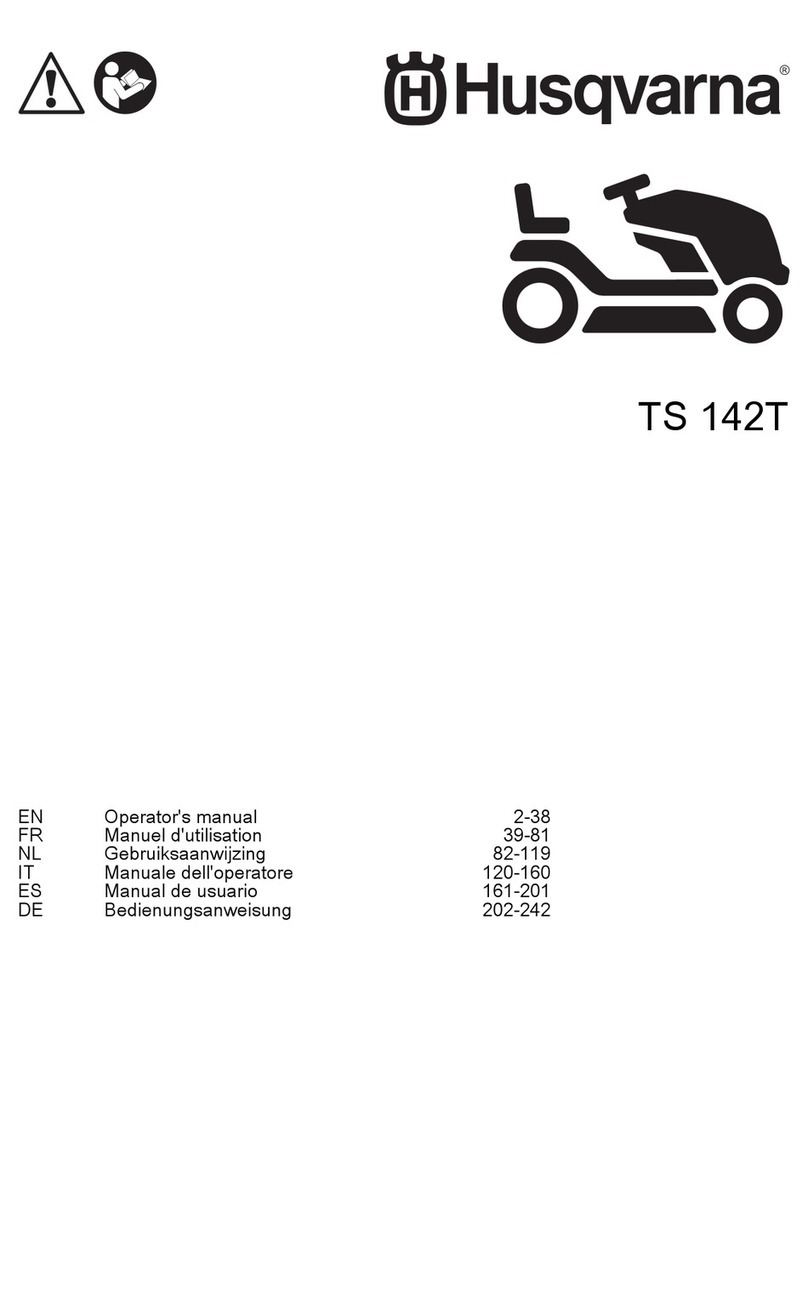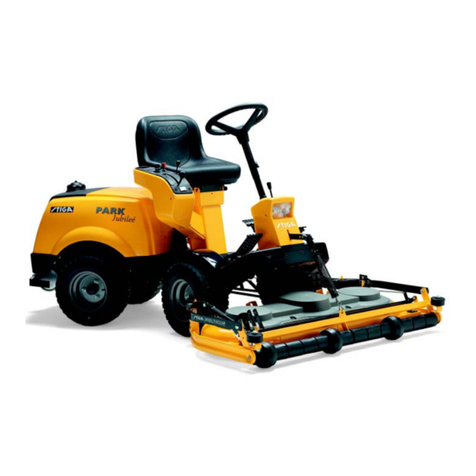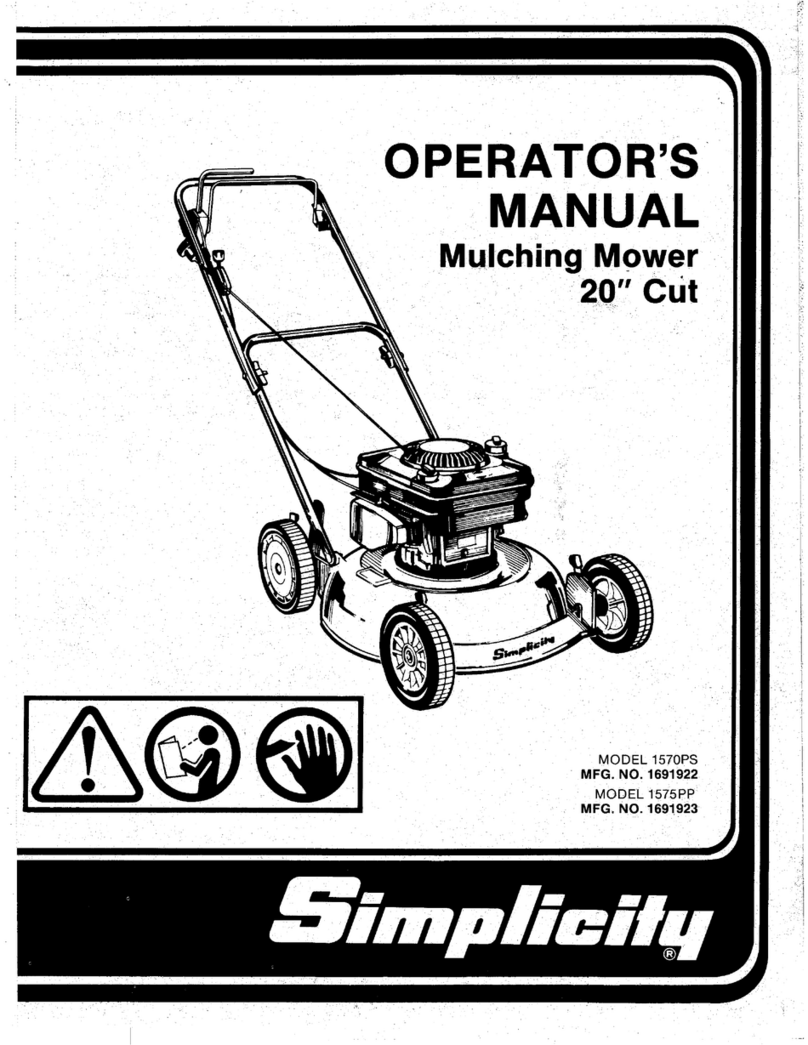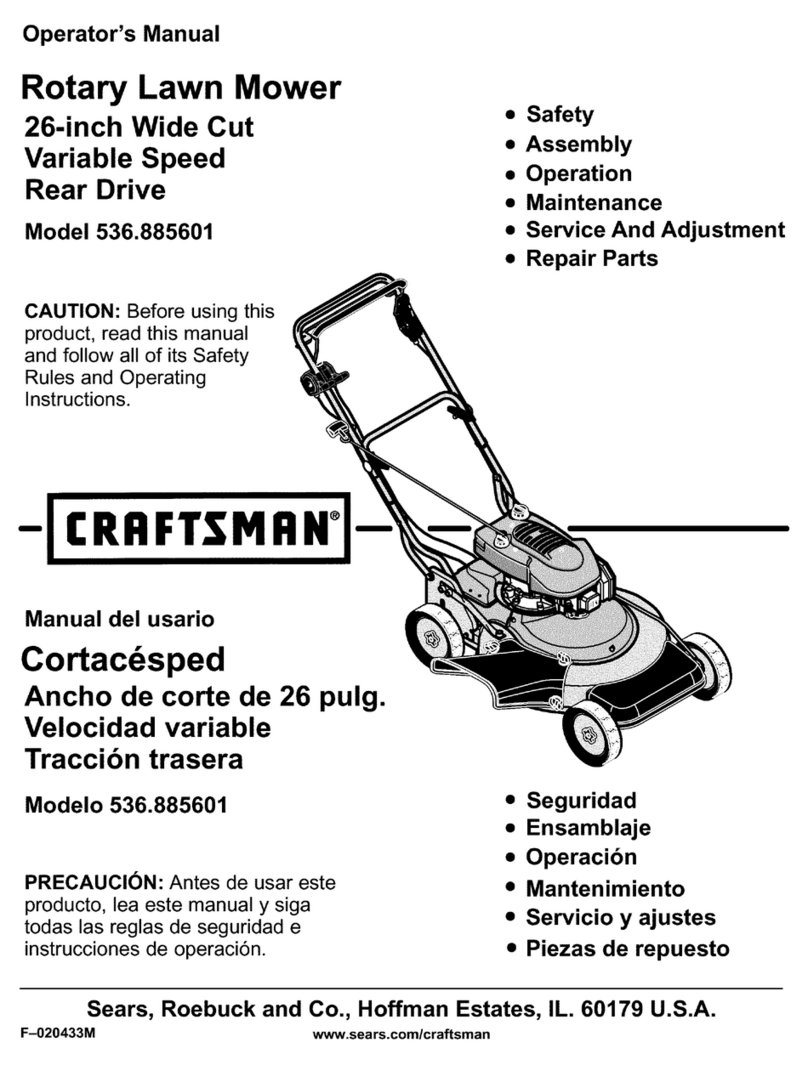Kunz AcrEase C60BE User manual

C60BE
H40B
H60B
1/18
40” & 60” FINISH CUT
OWNER’S MANUAL
With Assembly Instructions
For Models: H40B, H60B & C60BE
KUNZ ENGINEERING, INC. / MENDOTA, IL 61342 / PH (815) 539-6954

cbxcbxcvb

1
SAFETY INTRODUCTION
Your safety, and the safety of others, is very important. To help you make informed
decisions about safety, we have provided operating procedures and other information on
labels and in this manual. This information alerts you to potential hazards that could hurt
you or others.
This safety alert symbol is used to indicate safety instructions. Follow these
instructions to avoid personal injury and/or property damage. Read and follow all
instructions in this manual and the included engine manual.
You will find important safety information in a variety of forms, including:
Safety Labels – on the mower.
Safety Messages – preceded by a safety alert symbol and one of three signal
words: DANGER, WARNING, or CAUTION.
These signal words mean:
DANGER:Indicates an imminently hazardous situation that, if not avoided, will result in
death or serious injury. This signal word is to be limited to the most extreme situations
typically for machine components which, for functional purposes, cannot be guarded.
WARNING: Indicates a potentially hazardous situation that, if not avoided, could result in
death or serious injury, and includes hazards that are exposed when guards are removed.
It may also be used to alert against unsafe practices.
CAUTION:Indicates a potentially hazardous situation that, if not avoided, may result in
minor or moderate injury. It may also be used to alert against unsafe practices.
This entire manual is filled with important safety information. Please read it
carefully.

2
IMPORTANT SAFETY INFORMATION
WARNING: Do not allow anyone to operate this equipment who has not fully read and
comprehended the safety manual and who has not been properly trained in the safe
operation of the equipment.
WARNING: Operator should be familiar with all functions of the unit.
DANGER:Keep hands, feet, hair and clothing away from moving parts.
WARNING: Remove all objects from the work area that might be picked up and thrown by
the blades.
WARNING: Do not mow when children and others are around.
WARNING: Keep all safety shields and deflectors in place during operation.
WARNING: Shut off the engine and allow the mower blades to come to a complete stop
before making any adjustments to the mower.
WARNING: Shut off engine before disconnecting the wing mower from the tow vehicle or
attempting to move the wing mower by hand.
WARNING: Never carry children or passengers.
WARNING: Do not allow children to operate this machine.
WARNING: Follow all safety precautions outlined by the manufacturer of the tow vehicle
being used to pull this product.
This entire manual is filled with important safety information. Please read it
carefully.

3
SAFETY SIGNS AND LOCATIONS
WARNING: Clean or Replace Any Safety Signs That Are not Readable or Damaged
Replacement decals can be purchased from your local dealer or
Kunz Engineering Inc.
Mendota, IL 61342
(815) 539-6954
www.kunzeng.com
275007 –
Warning Decal,
Belt Shield
275003 –
Danger Decal,
Cut Hand & Foot
275002 – Warning Decal,
General
Serial # & Model # Decal
Models H60B & C60BE

4
SAFETY SIGNS AND LOCATIONS
WARNING: Clean or Replace Any Safety Signs That Are not Readable or Damaged
Replacement decals can be purchased from your local dealer or
Kunz Engineering Inc.
Mendota, IL 61342
(815) 539-6954
www.kunzeng.com
275007 –
Warning Decal,
Belt Shield
275003 –
Danger Decal,
Cut Hand & Foot
275002 – Warning Decal,
General
Serial # & Model # Decal
Model H40B

5
ASSEMBLY INSTRUCTIONS
READ THE COMPLETE ASSEMBLY INSTRUCTIONS BEFORE STARTING THE ASSEMBLY.
You should have:
-one mower deck assembly
-two caster assemblies
-two rear axle assemblies
-one tongue assembly (Lawn & Garden Hitching or ATV Tongue)
-one tow vehicle hitch assembly (only included on Lawn & Garden Hitching)
Optional hitches:
-one tongue extension
-one rear hitch assembly
A. ASSEMBLY OF MOWER WHEELS
1. Set the mower deck assembly on wood blocks so that it is suspended off the ground.
Figure 1. Assembly of Wheels, Tongue and Rear Hitch
2. Install the two caster assemblies in the retainers on the front of the mower deck. See figure 1.
Before securing the caster supports, determine which side of the mower the tongue will be
placed on and install the caster support stop on the tongue side. See Figure 2. Secure with
3/8” x 2-3/4” hex head bolt, lock washer, and nut provided in the retainer areas.
Note: The operator controls are on the front of the deck and the discharge chute is on the right
side. (Left and right are determined from looking in the direction of travel.)
3. Install the two rear axle assemblies in the retainers on the rear of the mower deck. The tire
should be to the left of the axle support. See figure 1. Secure with 3/8” x 2-1/2” hex head
bolt, lock washer, and nut provided in the retainer areas.
Retainer Bolts
Tongue Pivot Bolt
Tongue – Attach to Either
Left or Right Caster Assy.
Left Rear Axle Assy.
Left Caster Assy.

6
Note: Tighten the four wheel assembly pivot bolts so that the wheel assemblies will not flop
down when the deck is raised off the ground.
Figure 2: Installation of Caster Support Stop
B. INSTALLATION OF LAWN & GARDEN HITCHING (refer to the Operation and Adjustment
Section for recommended hitching)(if the ATV Tongue was purchased refer to section C.
Installation of ATV Tongue)
1. The tongue can be installed either on the left or right caster assembly depending on how the
wing mower will be towed. See figure 1. Tighten the lock nut on the 3/8” x 2-1/2” pivot bolt so
the tongue is free to pivot but does not move sideways.
Note: The tongue can be installed upside down so it will match up with tow vehicles with
higher hitches.
2. The tow vehicle hitch provided is a universal hitch that should fit most tow vehicles. Slight
modifications may be necessary for some tow vehicles.
3. Attach the tow vehicle hitch to the tow vehicle draw bar top or bottom depending on best
support, and secure with the longer 1/2” hex head bolt, flatwasher, nut, and lockwasher
provided. See figure 3.
Note: On some tow vehicles the draw bar will need to be strengthened to support the hitch
assembly securely.
4. Adjust the hitch stop angle with stop bolts as close as possible to the vertical member on the
back of the tow vehicle and adjust stop bolts securely against vertical member to keep hitch
from pivoting from side to side.
Note: The hitch should be positioned on the tow vehicle so the stop bolts have a solid member
to adjust to. On most tow vehicles two bolts can be used to attach the hitch assembly to
the draw bar, eliminating the need for the hitch stop angle.
Caster Support Stop
Caster Support
Tongue

7
5. The telescoping hitch can either be installed to the left or right and should clear the back of the
tire by about 2”.
6. If one mower is pulled on both the left and right side of the tow vehicle, then one telescoping
hitch can be mounted to the left and one to the right.
Figure 3: Installation of Tow Vehicle Hitch
Figure 4. Assembly of Hitch Pivot and Tongue
Telescoping Hitch -Install to Left
or to Right or in Both Directions
When Pulling Two Wing Mowers.
Hitch Stop Angle
Adjust Stop Bolt to
Back of Tow Vehicle
Screw Pin
Shackle Clevis
Offset Tongue Position
Direct Behind Tongue Position
Hitch Pivot – Attach
to either Left or Right
Caster Assy.
Tongue

8
C. INSTALLATION OF ATV TONGUE ASSEMBLY (if the lawn and garden hitching was purchased
refer to Section B. Installation of Lawn & Garden Hitching)
1. The tongue can be installed either on the left or right caster assembly depending on how the
wing mower will be towed. See figure 4. Secure the hitch pivot on the chosen caster
assembly with the 3/8” x 2-1/2” hex head bolt, lock washer, and nut provided.
2. Install the tongue into the hitch pivot and secure by placing a 5/16” wire lock pin on each side
of the hitch pivot.
D. INSTALLATION OF OPTIONAL HITCHES
1. When a long tongue is needed, remove the tongue pivot angles and spacer from the tongue
assembly and attach to the tongue extension. See figure 5. Slip the tongue in between the
two flats on the tongue extension and secure with 3/8” x 2-1/2” hex head bolts, lock washers,
and nuts provided.
2. When a second mower is pulled behind the first mower in tandem, then the rear hitch can be
installed on the left rear axle assembly. See figure 5. Secure with 3/8” x 3-1/4” hex head
bolts, lock washers, and nuts provided.
Note: The long tongue extension (Part # 900008) and rear hitch assembly (Part # 900009) must
be ordered separately.
Figure 5: Long Tongue Assembly and Rear Hitch Assembly
OPERATIONS AND ADJUSTMENTS
This safety alert symbol is used to indicate safety instructions. Follow
these instructions to avoid personal injury and/or property damage. Read
and follow all instructions in this manual and the included engine manual.
WARNING: Do not allow anyone to operate this equipment who has not fully read and
comprehended the safety manual and who has not been properly trained in the safe
operation of the equipment.
WARNING: Operator should be familiar with all functions of the unit.
Long Tongue Extension
Tongue Pivot Angle
Spacer
Short Tongue
Rear Hitch Assembly
Attach to Left Rear Axle

9
A. HITCH CONFIGURATIONS (Refer to Figure 6)
WARNING: Shut off the engine and allow the mower blades to come to a complete stop
before adjusting the spreader hitch on the tow vehicle.
Figure 6: Wing Mower Towing Suggestions and Required Hitches
Tow Vehicle without a Mower Deck
Tow Vehicle with a Mower Deck
1 & 2 combined
or 5
1, 2, & 3 combined
or 5
2 & 4
combined
2 & 3
combined
1 & 2 combined
or 5
1, 2, & 3
combined
1 & 2
combined
2 & 4
combined
1, 2, & 3
combined
1 & 2
combined
Listed above are all of the possible configurations of the wing mowers. The
numbers listed below each wing mower correspond to the hitch or combination of
hitches required to complete that possible configuration.
1. Tow Vehicle Hitch (Telescoping Hitch)
2. Short Tongue
3. Long Tongue Extension
4. Rear Hitch Assembly
5. ATV Tongue Assembly

10
The hitching system is designed so that the wing mower can be pulled directly behind a tow
vehicle without a mower deck or as a left or right wing mower when towed behind a tow vehicle
with or without a mower deck.
If more than one wing mower is towed, they can be pulled in tandem or one on the left and one on
the right or a combination of the above conditions until the desired cutting width is obtained.
CAUTION: Do not operate two wing mowers in tandem on slopes greater than 25% (1 foot
rise, 4 foot run). This can create an unstable condition where the rear wing mower could
push the front wing mower sideways.
When mowing large open areas, adjust the spreader hitch on the tow vehicle so that the wing
mower tongue center line aligns with the outside cut line on the tow vehicle mower. When
trimming around objects or mowing contours, it is best to adjust the tow vehicle hitch in to
eliminate skips. The spreader hitch can be adjusted in and out to get the desired overlap to fit
your mowing job.
B. ATV TONGUE CONFIGURATIONS (Refer to Figure 6)
WARNING: Shut off the engine and allow the mower blades to come to a complete stop
before adjusting the tongue.
WARNING: When attaching the tongue to the back of the tow vehicle, tighten the screw
pin shackle clevis firmly. Property damage or bodily injury may occur if the screw pin
shackle clevis unturns and the wing mower becomes unattached from the tow vehicle.
The hitching system is designed so that the wing mower can be pulled directly behind a tow
vehicle without a mower deck or as a left or right wing mower when towed behind a tow vehicle
with or without a mower deck.
Note: When pulling the wing mower directly behind, it is most maneuverable when the hitch
pivot is fastened on the left carrier arm. See Figure 4.When pulling the wing mower in
the offset position, it is most maneuverable to have the hitch pivot fastened on the right
carrier arm. See Figure 4.
The tongue is designed to adjust from left to right within the hitch pivot. This allows the wing
mower and tow vehicle, with a mower deck, to have proper overlap. Overlap is more critical in
tight areas where a lot of maneuvering is required. This overlap will eliminate most skips between
the tow vehicle and wing mower. In large open areas the overlap is not as critical and should be
adjusted to the user’s preference.

11
C. ADJUSTING CUTTING HEIGHT
WARNING: Shut off all engines and allow the mower blades to come to a complete stop
on the wing mowers and on the tow vehicle before adjusting the cutting height.
The cutting height can be adjusted in a range from 1.0" to 4.0". This is accomplished by adjusting
the height adjusting bolts on each of the four corners of the wing mower. See Figure 7. Turn the
bolts clockwise to raise the mower cutting height and counter-clockwise to lower the mower
cutting height.
When more than one mower is used at a time, it is very important to have all the mowers adjusted
as close to the same cutting height as possible to obtain a high quality cutting job.
Adjust the mowers as follows:
1. Pull the mowing unit on to a smooth, level surface.
2. Adjust the tow vehicle mower deck (If applicable) to the desired cutting height and level both
fore and aft and side to side.
3. Measure the distance from the level surface to the mower blade cutting edge on the tow
vehicle.
DANGER: Shut off tow vehicle engine and allow mower blades to stop completely before
attempting to measure the cutting height.
Figure 7: Adjusting Wing Mower Cutting Height
Adjust Anti-Scalp Wheels
Under Deck to the Upper or
Lower
Cutting Range
Height Adjustment Bolts
Snug 4 Bolts to
Eliminate Side
Movement
Cutting Height
Measure the Distance
and Add 5/16” to get
Cutting height
Mower Blade
Lower Edge
of Deck
Adjust for Upper or
Lower Cutting Range
5/16”
Smooth Surface

12
4. Adjust the cutting height on the wing mower so that it cuts at the same height as the tow
vehicle mower. Adjust each corner of the wing mower so that the distance form the smooth
surface to the bottom edge of the deck is equal to the cutting height minus 5/16”. The mower
blade cutting edge is 5/16” above the lower edge of the deck.
Note: To mow in the lower half of the cutting range, set the front caster axles in the bottom
setting and set the anti-scalp wheels in the top hole. To mow in the upper half of the
cutting range (original factory setting), set the front caster axles in the top setting and
set the anti-scalp wheels in the bottom hole.
Note: After the cutting height has been set, be sure to tighten the pivot bolts securely to
eliminate free pivoting of the front casters or rear axles. Snug the four bolts just beyond
the height adjust bolt so the front casters and rear axles can be adjusted up and down
but cannot move from side to side.
D. STARTING ENGINE
WARNING: Set parking brake on tow vehicle.
Attach wing mower tongue to tow vehicle.
WARNING: Do not start wing mower unless it is attached to the tow vehicle.
Turn on the fuel shut off valve (red colored rotating knob) located inline on the fuel hose. The off
position on the valve is when the red handle lines up with the “O” symbol.
For Model C60BE:
Set the choke to the desired position.
Start engine and allow engine to warm up.
Set the engine speed at about half throttle and engage the mower blades clutch by pulling
outward on the PTO switch. (The PTO switch is located at the front of the mower deck on the
control panel.)
Note: To help extend the life of the clutch the engine rpm should be placed as low as possible
before clutch engagement. If the engine should stall during clutch engagement, raise
the engine rpm until clutch engagement is possible.
CAUTION: If the mower’s engine dies while in use, remove the wing mower from the
uncut area before attempting to engage the clutch. Inspect the blades for any obstructions
that may prevent blade engagement. Failure to follow these instructions may result in
premature clutch and belt failure or a fire.
Adjust engine speed to full throttle.

13
CAUTION: The engine full speed setting with mower blades running is 3350 RPM.
For Model H60B:
Set the choke to the desired position.
Set the throttle lever in the start position at about half throttle. The mower blades clutch will
engage as the engine comes up to speed. The mower blades clutch engages at 1850 RPM.
Start engine and allow engine to warm up.
Adjust the choke to off.
Adjust engine speed to full throttle to fully engage the mower blades clutch.
CAUTION: Clutch overheating or failure may occur if engine is not run at full speed in
heavy load conditions.
CAUTION: The engine full speed setting with mower blades running is 3350 RPM.
For Model H40B:
Set the throttle lever in the choke position to set the choke. (The throttle lever is located on the
right side of the engine.)
Start engine and move throttle toward slow position to disengage choke.
Slow engine speed and engage mower blades clutch handle. (The clutch handle is located at
the front of the mower under the engine.)
Note: Some belt squealing may occur on engagement. This is normal for a manual clutch
engagement design.
CAUTION: If the mower’s engine happens to quit while in use take care to remove the
wing mower from the uncut area before attempting to engage the clutch. Also inspect the
blades for any obstructions that may prevent blade engagement. Failure to do either may
result in premature belt failure or even a fire.
Adjust engine speed to fast position for full throttle. (The full throttle is located at the detent
position on the throttle control.)

14
E. SHUTTING OFF WING MOWER
WARNING: Shift to neutral, disengage power to the mower deck, and set the parking
brake before dismounting the tow vehicle.
For Model C60BE:
Slow the engine speed down and disengage the clutch by pushing inward on the PTO switch.
Allow engine to cool down for a short time before moving the ignition switch to the off position.
Turn off the fuel shut off valve (red colored rotating knob) located inline on the fuel hose. The
off position on the valve is when the red handle lines up with the “O” symbol.
For Model H60B:
Set the throttle to slow so the mower blades clutch will disengage.
Allow engine to cool down for a short time before moving the ignition switch to the off position.
Turn off the fuel shut off valve (red colored rotating knob) located inline on the fuel hose. The
off position on the valve is when the red handle lines up with the “O” symbol.
For Model H40B:
Slow the engine speed down and disengage the clutch handle.
Allow engine to cool down for a short time before moving the throttle control to the stop position.
Turn off the fuel shut off valve (red colored rotating knob) located inline on the fuel hose. The
off position on the valve is when the red handle lines up with the “O” symbol.
F. MOWER OPERATION
DANGER:Keep hands, feet, hair and clothing away from moving parts.
CAUTION:Clean or replace any safety signs that are not readable or damaged.
WARNING: Remove all objects from the work area that might be picked up and thrown by
the blades.
WARNING: Do not mow when children and others are around.
WARNING: Do not fill fuel tank while engine is running or hot.

15
WARNING: Keep all safety shields and deflectors in place during operation.
CAUTION: Remove grass build up from under safety shields before each use. Do not
remove safety shields while engine is running. Dry grass build up around belts and
sheaves can cause fires.
WARNING: Shut off engine before disconnecting the wing mower from the tow vehicle or
attempting to move the wing mower by hand.
WARNING: Never carry children or passengers.
WARNING: Do not allow children to operate this machine.
CAUTION: Slow down and watch the ends of the wing mowers when making turns so
objects are not struck and/or run over.
Depending on the number of wing mowers being towed, it is usually more efficient to mow the
large areas first with the full system. Once the large areas are completed, mowers can be
dropped off to mow narrower areas.
Backing up with one wing mower is easy. Backing becomes a greater challenge as additional
wing mowers are towed. Avoid backing up by planning ahead. Make loops instead of backing.
WARNING: Look down, to the sides, and behind before and while backing to avoid
backing over something or someone. Care should also be taken while backing so that the
wing mower or mowers do not jackknife and damage hitches.
WARNING: Stop the mower blades on both the tow vehicle and all wing mowers if the tow
vehicle becomes stuck or stops going forward because of loss of traction. Shut off the
engines on the wing mowers before attempting to push or pull the tow vehicle.
CAUTION: Do not turn too sharply when the wing mowers are pulled in tandem or pulled
behind a zero turn mower. Sharp turns can force the mowers into each other causing
damage to the hitches.
Listen to the wing mower engines while mowing. The engines should run free and not work too
hard. Working the engine too hard will cause overheating and premature failure.
Do not allow material to build up on the air inlet to the engine cooling system. If the wing
mowers are towed with one on the left and one on the right side, there will be a lot of material
blowing around the right wing mower engine. Special care should be taken to make sure the
engine is getting enough inlet air. Do not allow the engine cooling fins under the shroud to be
blocked. Air flow over the engine will be restricted causing the engine to overheat.

16
Mowing to fast in very heavy, long grass can cause the wing mower engine to pull down and
disengage the blade clutch. The engine can then start to accelerate again while slipping the
clutch. Small amounts of clutch slippage for a few seconds will not cause damage. If the clutch
is allowed to slip for longer periods, it will overheat and could be damaged. Watch the discharge
chute; if material is not being discharged, then the clutch is slipping. In normal conditions, clutch
slippage will not be a problem. In most cases the clutch can be repaired by replacing the clutch
springs and clutch bearing.
CAUTION: If the mower blades are allowed to stall out (stop turning) at engine speeds
above the clutch engagement speed, this will cause the clutch to slip. If the clutch is
allowed to slip for more than five minutes, the clutch will get red hot and could cause the
drive belt to start burning.
G. DRIVE BELT REMOVAL AND TENSION
WARNING: Shut off engine and allow mower blades to stop turning before making any
adjustments or repairs.
Remove the safety shields.
Loosen the nuts on the spring-loaded idler; adjust the nut until the belt can be slipped off the
idler and drive sheaves.
Slip the belt down under the drive sheave and off the blade spindle sheaves.
Install the new belt and adjust the tension as follows:
Figure 8: Belt Pattern and Spring Adjustment (Model H60B)
Front
Engine
Initial Spring Length 15/16”
Running Spring Length 1-1/8” to 1-1/4”

17
Model H60B: – See Figure 8.
Adjust the spring-loaded idler springs to a compressed length of 15/16” initially for a few hours
until the belts run in; then adjust the spring to 1-1/8” to 1-1/4” compressed length.
Model C60BE: – See Figure 9.
Adjust the spring-loaded idler springs to a compressed length of 15/16” initially for a few hours
until the belts run in; then adjust the spring to 1-1/8” to 1-1/4” compressed length.
Figure 9: Belt Pattern and Spring Adjustment (Model C60BE)
Model H40B – See Figure 10.
Take special care to make sure that the belt is placed between the brake stud and the idler pulley.
With the clutch engaged, adjust the nuts on the spring-loaded idler adjuster bolt until the length of
the spring is approximately 2-3/4”. The running spring length should be maintained between 2-
3/4” and 3-1/4”. For maximum belt life, periodic checks should be done to make sure the spring
length has not exceeded the maximum recommended running length.
Note: Failure to periodically adjust the belt tension will result in severe belt wear and
premature belt failure.
This model comes with a belt brake, which is a safety feature that stops the blades from turning
after the clutch is disengaged. The only time the brake should be in contact with the belt is when
the clutch is disengaged.
Front
Engine
Initial Spring Length 15/16”
Running Spring Length 1-1/8” to 1-1/4”

18
CAUTION: The brake stud may need to be adjusted if there is significant belt wear or if a
different size belt is used. If the brake stud is not adjusted correctly, the blades will still
spin even though the clutch may be in the disengaged position. Always shut mower
engine off before servicing.
Under normal operating conditions the brake stud should require very little adjustment. Periodic
brake stud inspections should be performed. There are two parts to inspecting the brake stud.
Those two inspections are the disengaged spring length and brake stud clearance.
Note: It is quicker to perform the disengaged spring length and brake stud clearance
inspections if done simultaneously.
Figure 10: Belt Pattern and Spring Adjustment (Model H40B)
Disengaged Spring Length:
This inspection must be performed to make sure that there is proper braking force to prevent the
blades from spinning when the clutch is in the disengaged position. With the clutch in the
disengaged position measure the spring length. The spring must be between 3-1/4” and 4” to
provide the appropriate braking force. If the spring length is over 4” it will be necessary to adjust
the brake stud closer to the belt. If the spring length is less than 3-1/4” it will be necessary to
adjust the brake stud further away from the belt. To make brake stud adjustments loosen the bolt
on the top of the brake stud and slide the brake stud in the slot. When the proper disengaged
spring length is achieved, tighten the bolt on the top of the brake stud. For this procedure do not
adjust the spring length. The spring length should only be changed when adjusting the belt
tension.
No Less Than 1/2” Clearance
With Clutch Engaged
0” With Clutch Disengaged
Brake Stud
Clutch Engaged Spring
Length 2-3/4” to 3-1/4”
Clutch Disengaged Spring
Length 3-1/4” to 4”
Clutch Arm
Engine
Front
Clutch Engagement
Only Include
Spring in
Measurement
This manual suits for next models
2
Table of contents
Other Kunz Lawn Mower manuals
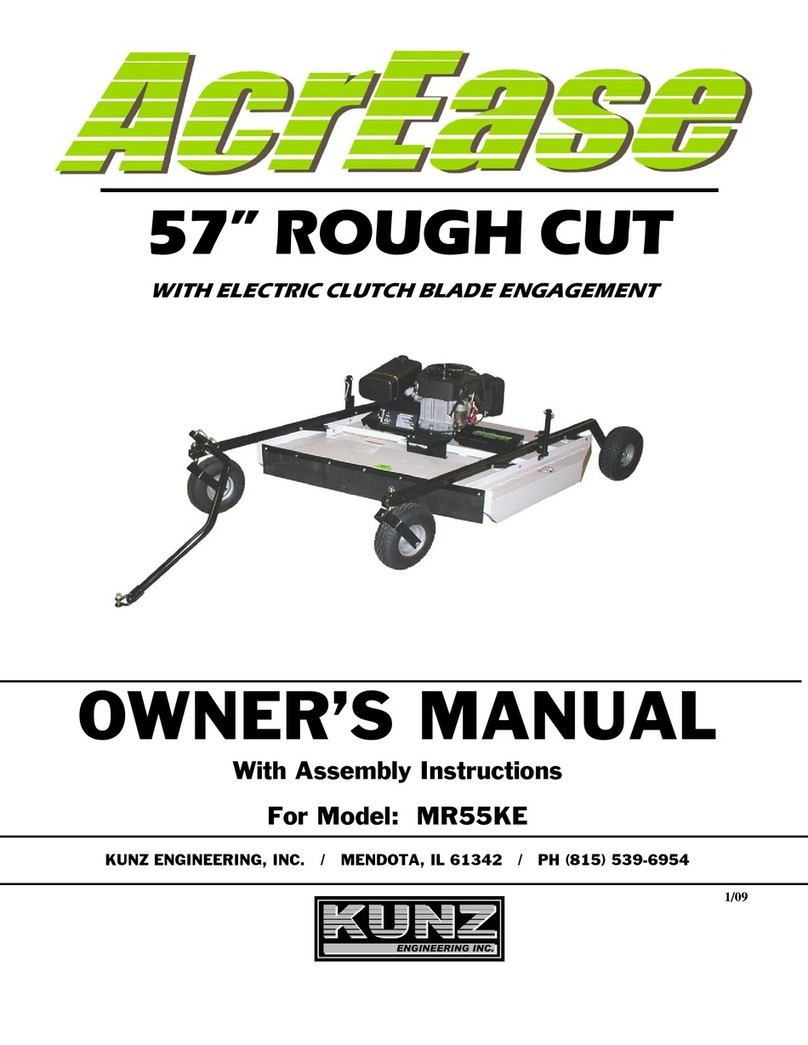
Kunz
Kunz AcrEase MR55KE User manual
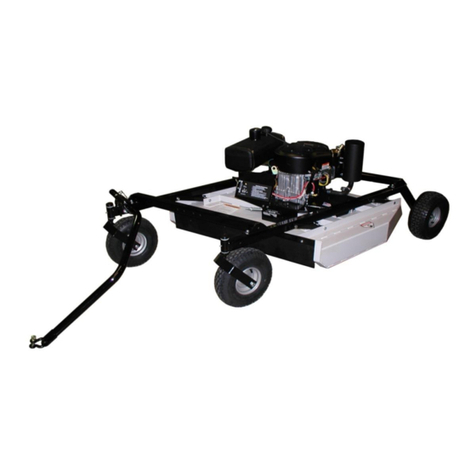
Kunz
Kunz AcrEase MR44B Datasheet
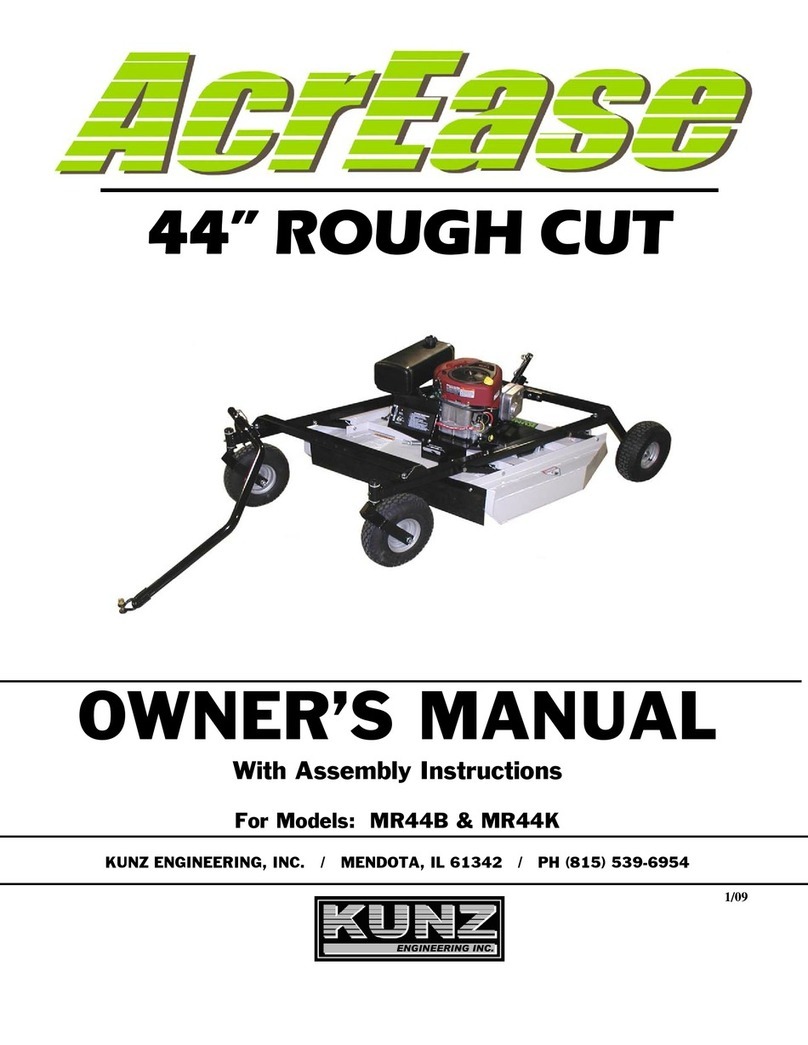
Kunz
Kunz AcrEase MR44B User manual

Kunz
Kunz AcrEase MR55KEI Datasheet
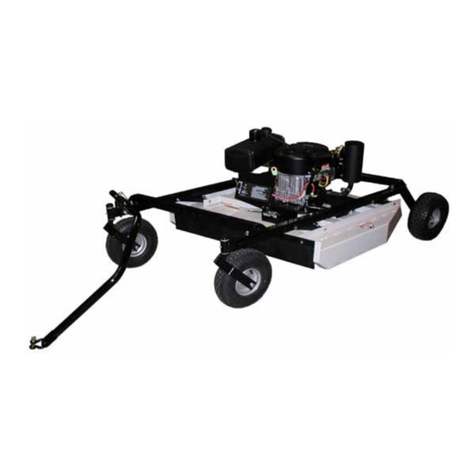
Kunz
Kunz AcrEase MR44BE Datasheet

Kunz
Kunz AcrEase MR55K Datasheet

Kunz
Kunz AcrEase MR55B User manual
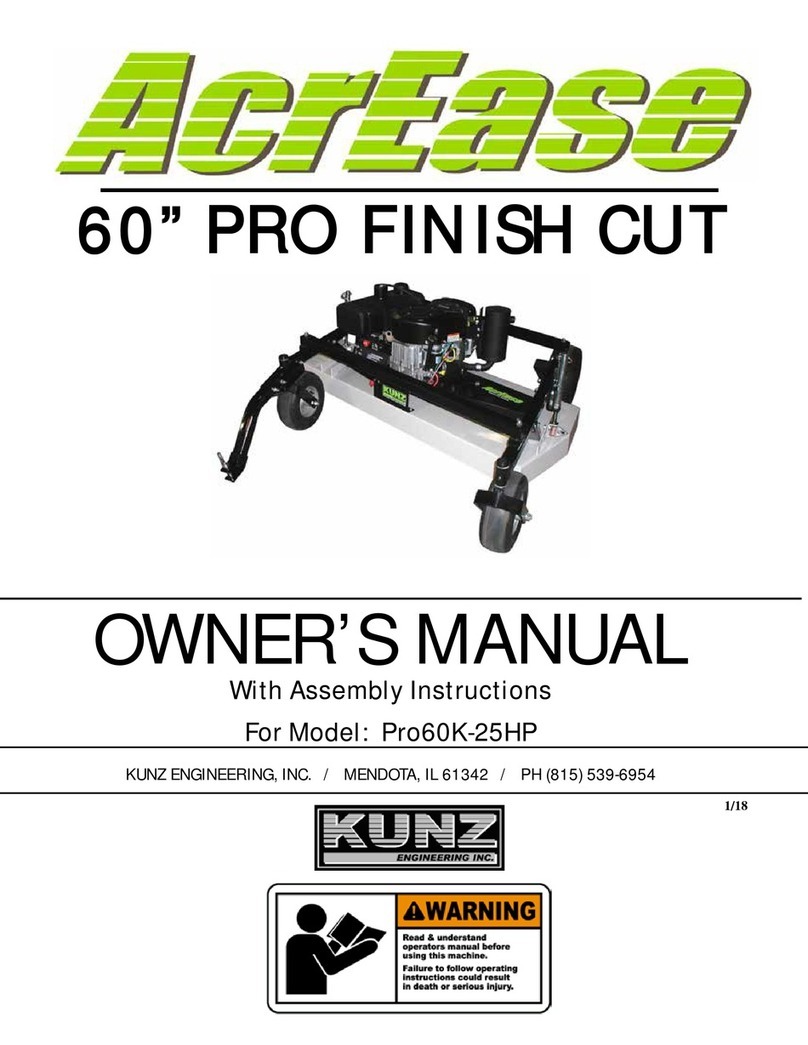
Kunz
Kunz AcrEase Pro60K-25HP User manual
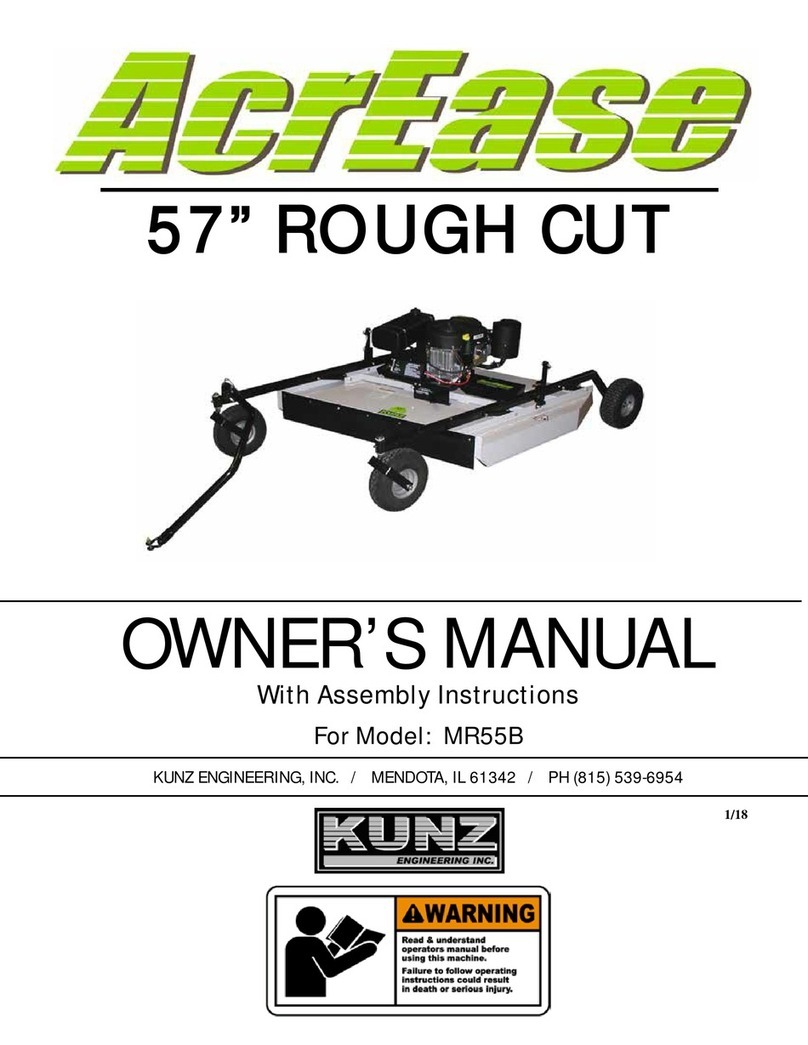
Kunz
Kunz AcrEase MR55B User manual
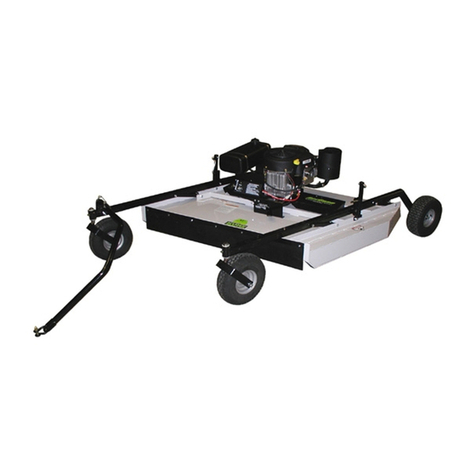
Kunz
Kunz AcrEase MR55BE Datasheet
